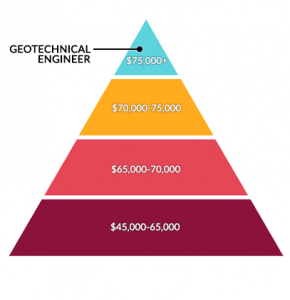Indicators on Geotheta You Need To Know
Table of ContentsExcitement About GeothetaGeotheta Can Be Fun For EveryoneSome Of GeothetaRumored Buzz on GeothetaHow Geotheta can Save You Time, Stress, and Money.

They perform site investigations, gather samples, execute laboratory tests, and assess data to review the viability of the ground for construction projects - Engineer of Record. Based on their findings, geotechnical designers supply referrals for structure design, slope stability, maintaining frameworks, and reduction of geotechnical dangers. They team up with various other specialists, such as engineers, structural designers, and construction teams, to ensure that geotechnical factors to consider are incorporated right into the overall project style and execution
By assessing the behavior and residential properties of soil and rock, they can determine potential geotechnical dangers such as landslides, soil settlement, or incline instability. Their experience helps avoid failures or crashes that can endanger lives and building. Right here are some comprehensive obligations and responsibilities of a geotechnical engineer: Website Investigation: Geotechnical engineers conduct website examinations to gather information on subsurface conditions.
They interpret the information to understand the properties and habits of the soil and rock, including their strength, leaks in the structure, compaction features, and groundwater problems. Geotechnical Evaluation and Style: Geotechnical engineers examine the data accumulated during site investigations to assess the stability and viability of the website for building and construction projects. They execute geotechnical estimations and modeling to review variables such as birthing ability, negotiation, slope security, side earth stress, and groundwater circulation.
Geotheta Things To Know Before You Get This
Foundation Design: Geotechnical designers play an essential function in designing structures that can safely sustain the designated structure. They analyze the soil problems and load needs to identify the appropriate structure type, such as shallow structures (e.g., grounds), deep structures (e.g (https://forums.hostsearch.com/member.php?265240-geotheta)., heaps), or specialized techniques like soil renovation. They think about elements such as settlement limitations, bearing capability, and soil-structure communication to establish optimum structure layouts
They evaluate building strategies, screen website tasks, and carry out area evaluations to verify that the layout suggestions are followed. If unforeseen geotechnical issues emerge, they analyze the circumstance and provide referrals for remediation or modifications to the layout. Threat Analysis and Mitigation: Geotechnical engineers examine geotechnical hazards and dangers connected with the project website, such as landslides, liquefaction, or dirt erosion.

Partnership and Interaction: Geotechnical designers function carefully with other specialists included in a job, such as architects, structural designers, and building and construction groups. Reliable communication and cooperation are crucial to integrate geotechnical considerations right into the overall task style and building and construction process. Geotechnical designers supply technical expertise, response inquiries, and make certain that geotechnical demands are met.
The Geotheta PDFs
Here are some sorts of geotechnical designers: Foundation Designer: Structure designers specialize in creating and assessing structures for frameworks. They evaluate the soil problems, tons needs, and website qualities to identify the most ideal structure kind and layout, such as shallow foundations, deep foundations, or specialized strategies like stack foundations.
They assess the elements affecting slope security, such as dirt residential or commercial properties, groundwater conditions, and incline geometry, and develop techniques to avoid slope failures and reduce dangers. Quake Engineer: Quake engineers focus on assessing and making frameworks to endure seismic forces. They assess the seismic hazard of a website, evaluate dirt liquefaction capacity, and develop seismic style requirements to make sure the safety and security and strength of structures during quakes.
They execute field screening, accumulate samples, and evaluate the collected information to identify the soil buildings, geologic developments, and groundwater conditions at a website. Geotechnical Instrumentation Designer: Geotechnical instrumentation engineers focus on surveillance and gauging the actions of dirt, rock, and structures. They install and keep instrumentation systems that keep track of factors such as dirt settlement, groundwater degrees, slope activities, and architectural displacements to examine link efficiency and offer very early cautions of prospective issues.
Geotheta Fundamentals Explained
They perform examinations such as triaxial tests, consolidation tests, straight shear examinations, and permeability tests to gather information for geotechnical analysis and design. Geosynthetics Engineer: Geosynthetics engineers concentrate on the style and application of geosynthetic products, such as geotextiles, geogrids, and geomembranes. They use these materials to enhance soil security, enhance slopes, supply drainage services, and control erosion.
They often tend to be investigatory individuals, which suggests they're intellectual, introspective, and inquisitive. They wonder, systematic, reasonable, logical, and logical. Some of them are likewise social, meaning they're kind, charitable, cooperative, individual, caring, practical, empathetic, skillful, and friendly. Does this seem like you? Take our complimentary job test to find out if geotechnical designer is one of your leading occupation suits.
In the workplace atmosphere, geotechnical engineers utilize specialized software program tools to perform calculations, develop designs, and evaluate information. They prepare reports, review project requirements, connect with clients and staff member, and coordinate project tasks. The workplace setting provides a conducive environment for study, evaluation, and partnership with other experts associated with the project.
Geotheta Can Be Fun For Everyone
They often visit project sites to conduct website examinations, analyze geotechnical conditions, and collect data for analysis. These check outs entail taking a trip to different locations, in some cases in remote or difficult surfaces. Geotechnical designers might perform dirt tasting, conduct tests, and display construction activities to make sure that the geotechnical facets of the project are being executed correctly.
Geotechnical engineers likewise work in specialized geotechnical laboratories. Geotechnical laboratory designers function extensively in these environments, dealing with testing equipment, operating tools, and videotaping information.